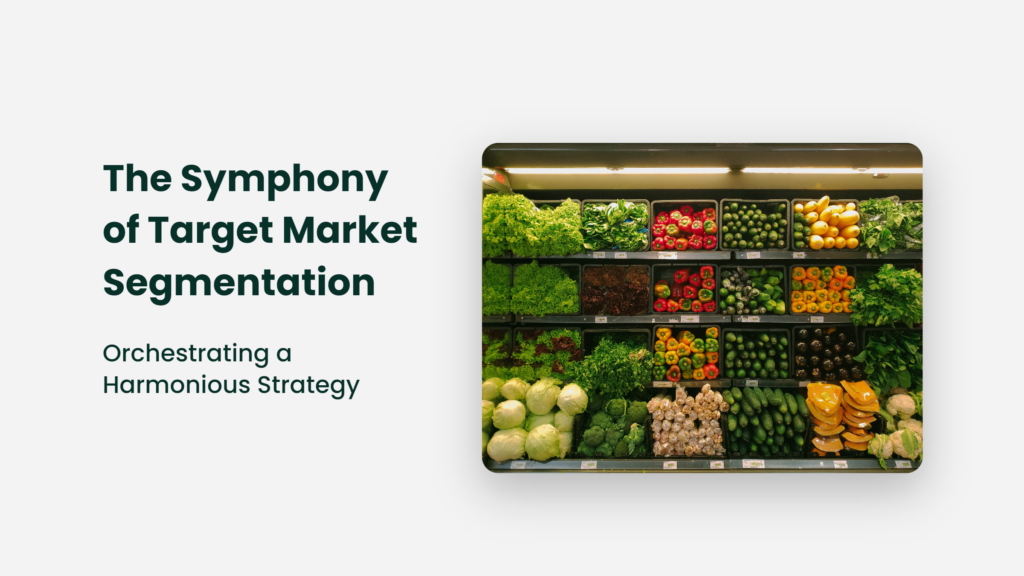

The Symphony of Target Market Segmentation: Orchestrating a Harmonious Strategy

As Seen On
In the grand concert hall of business, your product or service is the symphony that resonates with your audience, filling the air with a melody of solutions to their problems, desires, and needs. But not every audience member taps their foot to the same beat. And that, dear reader, is where the music of target market segmentation plays its magical tune.

Setting the Stage: What is Market Segmentation?

Market segmentation divides your broad target market into smaller, more manageable target market segments based on specific characteristics. It’s akin to an orchestra, where each instrument group plays a unique part, yet together they create a harmonious symphony.
I hope caviar goes well with juice boxes! But why go through all the trouble of segmenting your market? Would you serve the same dish at a kids’ party and a gourmet dinner?
The Maestro’s Baton: The Four Types of Market Segmentation
There are four main types of target market segmentation: demographic, geographic, psychographic, and behavioural. Each is like a section of the orchestra, each playing a different instrument but all working together to create a rich, harmonious melody.
1. Demographic Segmentation: This is the violin section of our orchestra – the most prominent and essential. It involves segmenting the market based on characteristics such as age, gender, income, education, and occupation.
2. Geographic Segmentation: Geographic segmentation is like the percussion section. It sets the pace and rhythm, grounding the melody. It involves segmenting the market based on location—city, state, country, or even climate.
3. Psychographic Segmentation: Psychographic segmentation is the woodwinds, providing depth and complexity to the symphony. It’s about your audience’s lifestyle, personality, values, opinions, and interests.
4. Behavioral Segmentation: Lastly, behavioural segmentation is the brass section, loud and clear. It’s about understanding your audience’s buying behaviour, usage rate, preferences, and loyalty.
The Music of Examples: The Success of Netflix

Netflix, the global streaming giant, is a maestro when it comes to target market segmentation process. They go deeper, creating micro-segments based on viewing habits, content preferences, and even the time and device used for streaming. They need to categorize their audience by age or location.
They know that the college student who binges on “Stranger Things” at 2 a.m. on their laptop has different needs than the working mom who watches “The Crown” on her smart TV after putting the kids to bed. This deep understanding allows Netflix to personalize recommendations, creating a unique and engaging experience for each user.
The Crescendo: Implementing Market Segmentation
Now, it’s your turn to conduct your symphony of market segmentation. It’s not about waving the baton randomly, hoping the music falls into place. It’s about purposeful, strategic movements that guide each section of your orchestra.
For instance, selling luxury skincare products might start with demographic segmentation, targeting high-income females aged 30-50. But then, you add layers of psychographic and behavioural segmentation. You target those who value organic ingredients and have a history of purchasing premium beauty products.
Suddenly, your melody becomes more refined and more appealing to the specific segment that resonates with your product.
An Encore: Pop Quiz!
Who said “divide and rule, is a good motto? Unite and lead a better one.”?
The Grand Finale: The Benefits of Market Segmentation

Properly conducted, target market segmentation can be like a virtuoso performance, leading to a standing ovation of business success. It can help you tailor your products, marketing messages, and overall marketing strategy to match each segment’s needs and wants. As legendary marketer Seth Godin once said, “Don’t find potential customers for your products; find products for your target customers.”
And the benefits of target market segmentation are more than just anecdotal. According to a study by Bain & Company, 81% of executives found that segmentation was crucial in increasing profits.
Frequently Asked Questions
What is the first step in market segmentation?
The first step in market segmentation is understanding your broader target market. You can identify meaningful segments once you have a clear picture of them.
Can a business target multiple market segments?
Yes, a business can target multiple market segments. However, ensuring that each component is distinct and that your product or service offers unique value is crucial.
How is my market segmentation effective?
Effective target market segmentation will result in distinct customer groups that respond differently to different marketing campaigns. You can measure effectiveness through metrics like sales, customer acquisition costs, and customer lifetime value within each segment.
Should market segment be static?
No, market segments are not static. As market conditions, customer preferences, and products or services change, your market segments may also need to evolve.
Final Thoughts
Market segmentation is a symphony of understanding and serving your audience better. It’s not just about making noise; it’s about making music your audience wants to hear. Its powerful music can turn a broad, undefined target audience into a finely-tuned, responsive, and profitable audience.
And if you’ve answered Johann Wolfgang von Goethe to the pop quiz, bravo!
You understand the importance of segmentation (Divide and rule) and the even more remarkable power of uniting those segments under a brand that leads. Keep orchestrating, keep playing, and your business symphony will resound with the sweet sound of success.
Konger
Up until working with Casey, we had only had poor to mediocre experiences outsourcing work to agencies. Casey & the team at CJ&CO are the exception to the rule.
Communication was beyond great, his understanding of our vision was phenomenal, and instead of needing babysitting like the other agencies we worked with, he was not only completely dependable but also gave us sound suggestions on how to get better results, at the risk of us not needing him for the initial job we requested (absolute gem).
This has truly been the first time we worked with someone outside of our business that quickly grasped our vision, and that I could completely forget about and would still deliver above expectations.
I honestly can't wait to work in many more projects together!
Disclaimer
*The information this blog provides is for general informational purposes only and is not intended as financial or professional advice. The information may not reflect current developments and may be changed or updated without notice. Any opinions expressed on this blog are the author’s own and do not necessarily reflect the views of the author’s employer or any other organization. You should not act or rely on any information contained in this blog without first seeking the advice of a professional. No representation or warranty, express or implied, is made as to the accuracy or completeness of the information contained in this blog. The author and affiliated parties assume no liability for any errors or omissions.

